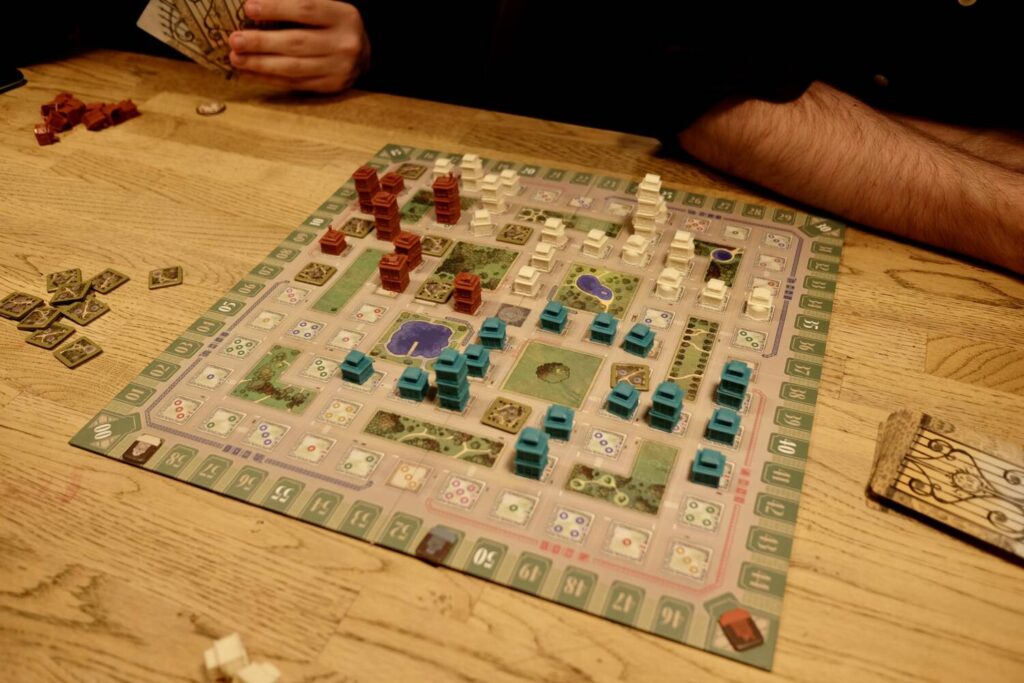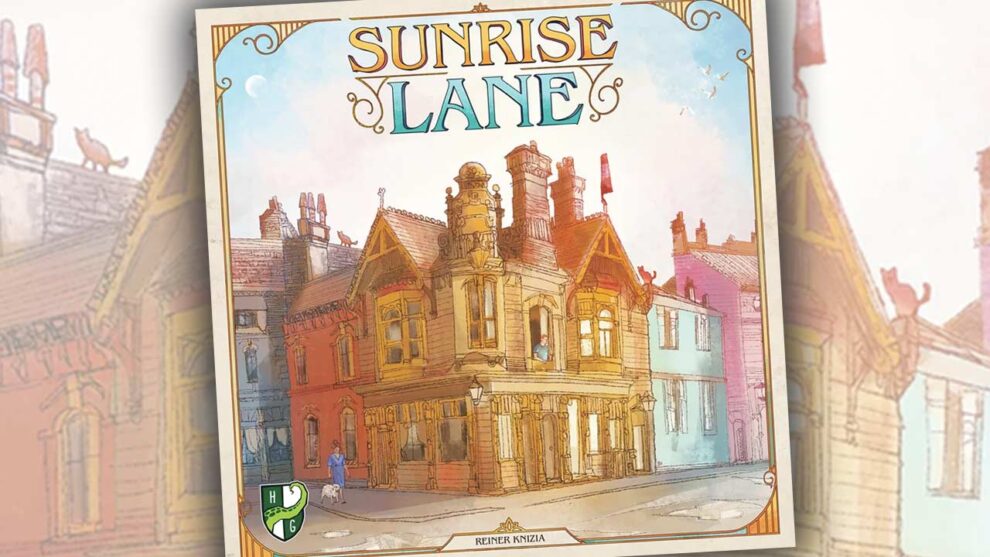
Sunrise Lane is a beefed-up reimplementation of designer Reiner Knizia’s 2012 game Rondo. On your turn, you either discard cards to build buildings, or you draw two cards. Building is nice and simple: the height and location of the building have to match the cards you’re discarding. If I discard one blue card, for example, I would place a single-story building on a blue space. If I discard three red cards, I would place a three-story building on a red space.
There are two restrictions on building. You have to build adjacent to either the central space or to other buildings, and, while you can build more than one building every turn, they have to continue in a single line from the first building you place on that turn. No popping up all over the board in a single go, and a good thing too; that would be far too powerful.

The bulk of your points come from building placements. Each space has not only a color, but a value, indicated by the number of pips on the space. You score that number multiplied by the number of stories on your building. Once a building is placed, it can’t be modified. It’s now or never.
Because any player can build on any accessible location, there’s a pleasant tension surrounding the decision to expand. You don’t want to build too close to a juicy spot, lest another player snap it up before you. At the same time, you have a hand limit of five cards, so you’re discouraged from waiting for the perfect hand. Better to be opportunistic.
Draw
The game is saved from dragging by two small design choices. First, when you discard to build, you end your turn by drawing a card. It’s a minor thing, but that stops the card economy from ever flat-out crashing. Second, you can always discard any card you want to cover a space with a park, so you don’t ever find yourself waiting five or six turns to get that one friggin’ color you need.

If you do find yourself in that situation, you’re probably not being opportunistic enough. Sunrise Lane is more about tactics than it is about deep planning. Carpe momentum and all that. It can be a bit more luck-dependent than some players may want, since the inherent RNG of the card draw can make a difference. If someone manages to snag a four- or five-point space with four or five cards of the right color, that can be as much as a third of a winning score.
Losing out on the high-value spaces isn’t the end of the world, though. The board is divided into four quadrants, each with a scoring bonus for either the most or the tallest buildings, and bonuses are also awarded for the largest groups of contiguous buildings at the end of the game. If your opponents are focused on trying to nag the valuable spots, you can content yourself to spread like a tumor, nabbing bonuses and wracking up invisible points.
Sunrise, Sunset
Horrible Guild have done a characteristically charming job with the production, though there are practical issues. Red and pink are far too close to one another. Blue, yellow, and green all stand out well enough for the most part, but there’s not enough color on the board for red and purple to differentiate themselves under most lighting. If you’re color blind, there are color-specific markings, but they’re so small as to be effectively useless. If the whole game were about 25% bigger, it would work as it is, but it’s not, so it doesn’t.

Sunrise Lane has a number of strengths. It’s punchy, it scales well for player count, and it’s easy to teach. It’s a solid choice for a family of mixed ages, since a seven or eight-year-old wouldn’t have any issue with the mechanics. My friend Jim got it exactly right when he said, “If anyone were to ever suggest Sunrise Lane, I’d say, ‘Yes, absolutely, that sounds great.’ But I’d never suggest it myself.” A lovely place for a walk, Sunrise Lane, but not the first neighborhood you’d choose to visit.












The game sounds like a good time. The color thing really bugs me, though. I thought we would have all learned this lesson collectively by now! I love, for example, the game Cosmic Encounter; I played a lot of the Mayfair version. I still get a bit of rage in my stomach over the two shades of blue that were used and kept causing issues.
The review was wonderful and did exactly what it needed to — it allowed someone like me to make an informed decision.